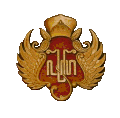YOGYAKARTA

The Kartasura Dynasty
BRIEF HISTORY
After the death of the Susuhanan Sri Paku Buwana II in 1749, a long drawn out succession dispute ensued. Prince Mangku Bumi refused to accept the succession of Sri Paku Buwana III, gained certain territories and attempted to seize power. After six years of War had resulted in a stalemate, with Mangku Bumi in control of the southwest. The Susuhanan retained control of the northeast, with Dutch military and political support. The latter tired of the expense and drain on resources, they decided to divide the empire into two new states, Surakarta under the Susuhanan and a new Sultanate of Yogyakarta under Mankubumi. The division was formally inaugurated on 13th February 1755, but it took another seventy-five years to settle the border between the two states.
After the defeat of Yogyakarta by British forces in 1811, the sultanate was divided and the new Viceroyalty of Pakualam established under loyal Prince Nata Kusuma on 22nd June 1812.
The return of the Dutch in 1816 did not prove popular amongst many Javanese. A major nationalist revolt, led by the Yogyakarta Prince Dipa Negara erupted in 1825, when he proclaimed himself as Sultan of Jawa. The war lasted five long years and drained Dutch very heavily. Eventually, his forces were defeated, he was captured and exiled with his family to Makassar in 1830. His name, however, lives on in nationalist legend.
The defeat of Japan in 1945 unleashed a major nationalist movement aimed at establishing independence from the Dutch. Although republican in aim, the movement strongly supported by the young Dutch-educated Sultan Amangku Buwana IX. On the return of Dutch forces to Java, and in the wake of their successes against the nationalists, he gave the fledgling nationalist leaders sanctuary. His standing in the community was so high that the Dutch were unwilling to risk public anger by invading the palace grounds.
Sultan Amangku Buwana IX joined the republican government, serving as a TNI General, senior Minister and eventually, Vice-President of the Republic. Consequently, Yogyakarta maintained a separate identity more succesfully than the other principalities of the former Netherlands East Indies. It became a separate administrative unit, the Sultan serving as Governor and the Viceroy Paku Alam as Lieutenant-Governor. On the Sultan's death in 1989, his son was not appointed as Governor. President Suharto attempted to fill the office with one of his henchmen, but public disquiet and discontent forced him to relent. Sultan Amangku Buwana X assumed office as Governor in 1998.
SALUTE: 19-guns.
STYLES & TITLES:
The ruling prince: Sampeyan Dalam ingkang Sinuhun Kanjeng Sri Sultan Amangku Buwana III Senapati ing Alaga Ngah 'Abdu'l-Rahman Saiyid ud-din Panatagama Khalifatu'llah ingkang Yumeneng Kaping (= the ruler who controls the universe, commander-in-chief, servant of the Lord, Lord of all believers).
The Royal consort of the Sultan (the padmi): Gusti Kanjeng Ratu (personal title).
The junior wives of the Sultan: Kanjeng Bandara Radin Ayu (personal title).
Heir Apparent: Kanjeng Gusti Pangeran Adipati Anum Amangku Negara Sudibya Rajaputra Nalendra ing Mataram.
The sons of the Sultan by his Royal consort: Gusti Radin Mas (personal name). They usually also receive princedoms on reaching their majority, being styled thereafter Gusti Bandara Pangeran Arya (personal title).
The sons of the Sultan by his junior wives, during minority: Bandara Radin Mas (personal name). They usually also receive princedoms on reaching their majority, being styled thereafter Bandara Pangeran Arya (personal title).
The grandsons and male descendants of a Sultan, in the male line: Radin Mas (personal name).
The daughters of the Sultan by the Royal consort, before marriage: Gusti Radin Ajeng (personal name), before marriage. The senior daughters usually also receive high titles on reaching their majority, being styled thereafter Gusti Kanjeng Ratu (personal title).
The daughters of the Sultan by the Royal consort, after marriage: Gusti Radin Ayu (personal title of husband).
The daughters of the Sultan by junior wives, before marriage: Bandara Radin Ajeng (personal name).
The daughters of the Sultan by junior wives, after marriage: Bandara Radin Ayu (personal title of husband).
The grand daughters and other female descendants of a Sultan, in the male line, before marriage: Radin Ajeng (personal name).
The grand daughters and other female descendants of a Sultan, in the male line, after marriage: Radin Ayu (personal title of husband).
RULES OF SUCCESSION:
Male primogeniture, the sons of royal wives taking precedence over those of the junior wives.
ORDERS & DECORATIONS:
Bintang Pusaka Kraton Buatan Yogyakarta (the Order of the Sacred Heirlooms of Yogyakarta Palace): founded by Sultan Amangku Buwana IV. Awarded in three classes (?).

Bintang Pusaka Kraton Buatan Yogyakarta - First class, breast star.
See under Indonesia main page.
SOURCES:
P.B.R. Carey (ed.). The Archive of Yogyakarta, Vol I Documents Relating to Politics and Court Affairs, The British Academy Oriental Documents Committee, Oxford University Press, 1980.
K.R.T. Mandoyokusumo, Serat Rajaputra Ngayogyakarta Hadi-ning Rat, Cap-capan IV, Bebadan Museum Karaton Ngayogyakarta Hadi-ning Rat, 1980. (a. 504) (SEA 1989).
M.C. Ricklefs, Jogjakarta under Sultan Mankubumi 1749-1792: A History of the Division of Java. Oxford University Press, London, 1974.
Mahamad Roem, Mochtar Lubis, and Kustinyati Mochtar dan S. Maimoen, Tahta Untuk Rakyat: Celah-celah Kehidupan Sultan Amangku Buwana IX, Penerbit PT Gramedia, Jakarta, 1982.
Oleh Sagimun M.D., Pahlawan Dipa Negara Berdjuang. P.T. Gunung Agung, Jakarta, 1965.
Aart van Beek, Life in the Javanese Kraton. Oxford University Press, Singapore, 1990.
SPECIAL ACKNOWLEDGEMENTS:
Stephen R. Bunford.
The late Jeffrey Finestone.
D. Tick, Pusat Dokumentasi Kerajaan-Kerajaan di Indonesia "Pusaka".
Copyright©Christopher Buyers, October 2001 - May 2014